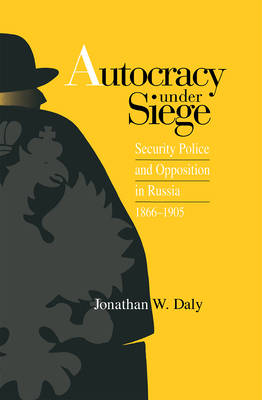
- Retrait gratuit dans votre magasin Club
- 7.000.000 titres dans notre catalogue
- Payer en toute sécurité
- Toujours un magasin près de chez vous
- Retrait gratuit dans votre magasin Club
- 7.000.0000 titres dans notre catalogue
- Payer en toute sécurité
- Toujours un magasin près de chez vous
Description
Imperial Russia's security police have long been popularly associated with administrative lawlessness, harsh repression, and throngs of spies. Shocking tales told by revolutionaries and tendentious Soviet accounts have perpetuated such views. Yet Russia's security service on the eve of the Revolution of 1905 was relatively small-scale, law-abiding, and humane, especially given the extent of social and politcal opposition the regim faced.
Autocracy under Siege examines the role of the security service in the titanic struggle between the regime and those dedicated to the defeat of monarchical absolutism. From the first terrorist attempt on the life of a Russian emperor in 1866 through the seismic upheaval of 1905, Daly traces the reaction, expansion, and evolution of the security police in the face of the increased antigovernment activity that threatened the continued survival of the regime.
Drawing upon a wealth of sources, including many recently declassified archival documents, Autocracy under Siege provides a detailed analysis of the personnel, institutions, and effectiveness of the imperial Russian security police. Daly further explores the interplay of regime and opposition when they confronted each other most directly in the years before the 1905 upheaval.
Through comparisons with western European police institutions, Daly ultimately reveals that, despite its infamous reputation, the imperial Russian security police actually resembled European models, a notion previously rejected by other historians. The most probing analysis to date of how and why Russia's security police developed, this study will prove essential to historian of Russia and Europe and to readers interested in the fields of politics, law, and revolution.
Spécifications
Parties prenantes
- Auteur(s) :
- Editeur:
Contenu
- Nombre de pages :
- 272
- Langue:
- Anglais
- Collection :
Caractéristiques
- EAN:
- 9780875802435
- Date de parution :
- 01-12-98
- Format:
- Livre relié
- Format numérique:
- Genaaid
- Dimensions :
- 159 mm x 237 mm
- Poids :
- 544 g

Les avis
Nous publions uniquement les avis qui respectent les conditions requises. Consultez nos conditions pour les avis.






